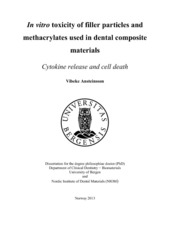| dc.contributor.author | Ansteinsson, Vibeke | en_US |
| dc.date.accessioned | 2014-01-13T14:09:01Z | |
| dc.date.available | 2014-01-13T14:09:01Z | |
| dc.date.issued | 2013-09-20 | eng |
| dc.identifier.isbn | 978-82-308-2364-4 | en_US |
| dc.identifier.uri | https://hdl.handle.net/1956/7667 | |
| dc.description.abstract | Dental polymer-based composite materials are complex materials consisting of several components, the main components being filler particles (inorganic component) and polymer matrix (organic component). The organic component consists of monomers that usually are polymerized upon activation by visible light illumination. The polymerization process is never complete, and leakage of unreacted methacrylate monomers occurs during clinical service. Degradation processes may weaken the bond between the fillers and the matrix, leading to release of fillers particles and ions in addition to the organic components. Clinical handling during placement and finishing has been shown to cause release of particulate matter to the air in dental clinics, which could be followed by exposure to tissue and saliva of the patients. Thus, both dental personnel and patients could be exposed to components of polymer-based dental materials. The main objective of the thesis was to characterize the toxic potential of selected inorganic filler particles (barium glass particles and silica particles) and methacrylates (HEMA, TEGDMA, BisGMA, GDMA, MMA) used in dental composite filling materials. The results showed that both nano- and micro-sized filler particles could modulate the release of inflammatory mediators in vitro. The methacrylates investigated induced cytotoxicity, but the potency and the mechanism involved seemed to differ between the methacrylates. HEMA was found to induce apoptosis and DNA damage followed by activation of DNA damage response. To address possible exposure to multiple components of polymer-based dental composite materials the effect of co-exposure to components was studied. An additive inflammatory response was observed with particles and TEGDMA co-exposure. Studies on the mechanisms of possible adverse biological responses to substances released from polymer-based dental materials could contribute to safer dental materials. | en_US |
| dc.language.iso | eng | eng |
| dc.publisher | The University of Bergen | eng |
| dc.relation.haspart | Paper I: Filler Particles Used in Dental Biomaterials Induce Production and Release of Inflammatory mediators in Vitro. Ansteinsson VE, Samuelsen JT, Dahl JE. Journal of Biomedical Materials Research B Applied Biomaterials. 2009, 89(1):86-92. The article is not available in BORA due to publisher restrictions. The published version is available at: <a href="http://dx.doi.org/10.1002/jbm.b.31190" target="blank">http://dx.doi.org/10.1002/jbm.b.31190</a> | en_US |
| dc.relation.haspart | Paper II: Cell toxicity of methacrylate monomers – the role of glutathione adduct formation. Ansteinsson V, Kopperud HB, Morisbak E, and Samuelsen JT. Journal of Biomedical Material Research A. 2013, 101(12):3504–3510. The article is not available in BORA due to publisher restrictions. The published version is available at: <a href="http://dx.doi.org/10.1002/jbm.a.34652" target="blank">http://dx.doi.org/10.1002/jbm.a.34652</a> | en_US |
| dc.relation.haspart | Paper III: DNA-damage, cell-cycle arrest and apoptosis induced in BEAS-2B cells by 2-hydroxyethyl methacrylate (HEMA). Ansteinsson V, Solhaug A, Samuelsen JT, Holme JA, Dahl JE. Mutation Research. 2011, 16;723(2):158-64. The article is not available in BORA due to publisher restrictions. The published version is available at: <a href="http://dx.doi.org/10.1016/j.mrgentox.2011.04.011" target="blank">http://dx.doi.org/10.1016/j.mrgentox.2011.04.011</a> | en_US |
| dc.relation.haspart | Paper IV: TEGDMA and filler particles used in dental composites additively attenuate LPS-induced cytokine release from the monocytemacrophage cell line RAW 264. Mathisen GH, Ansteinsson V, Samuelsen JT, Dahl JE, Becher R, Bølling AK. Submitted. The article is not available in BORA. | en_US |
| dc.title | In vitro toxicity of filler particles and methacrylates used in dental composite materials. Cytokine release and cell death | en_US |
| dc.type | Doctoral thesis | |
| dc.rights.holder | Copyright the author. All rights reserved | |
